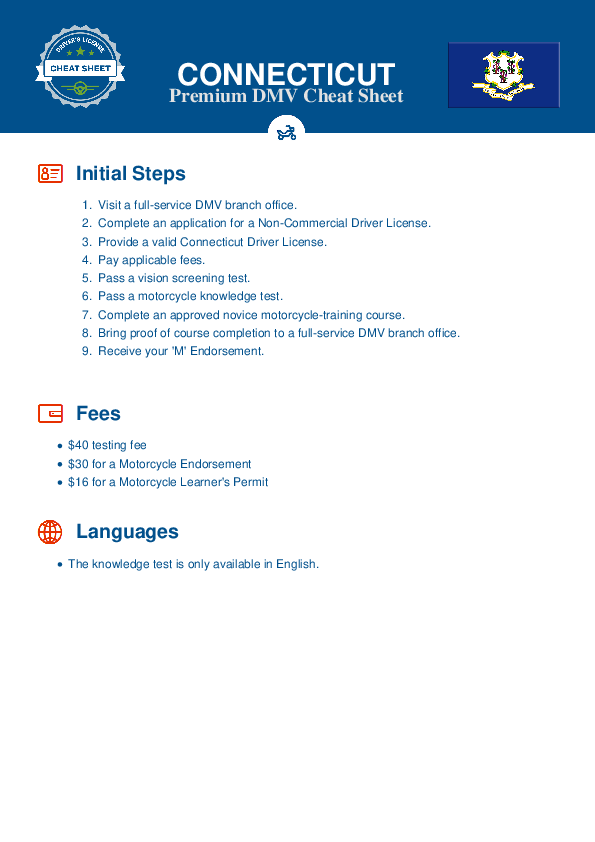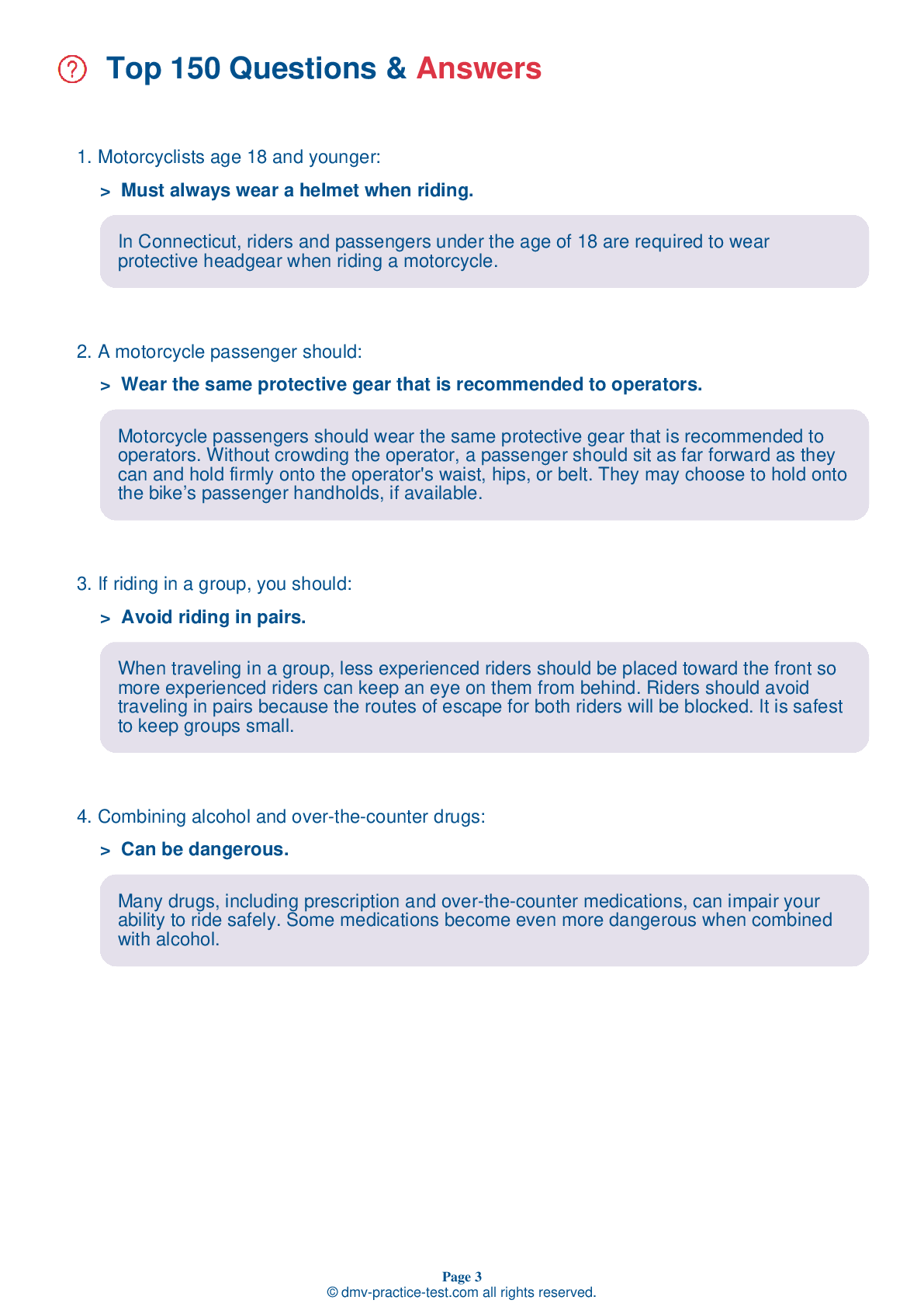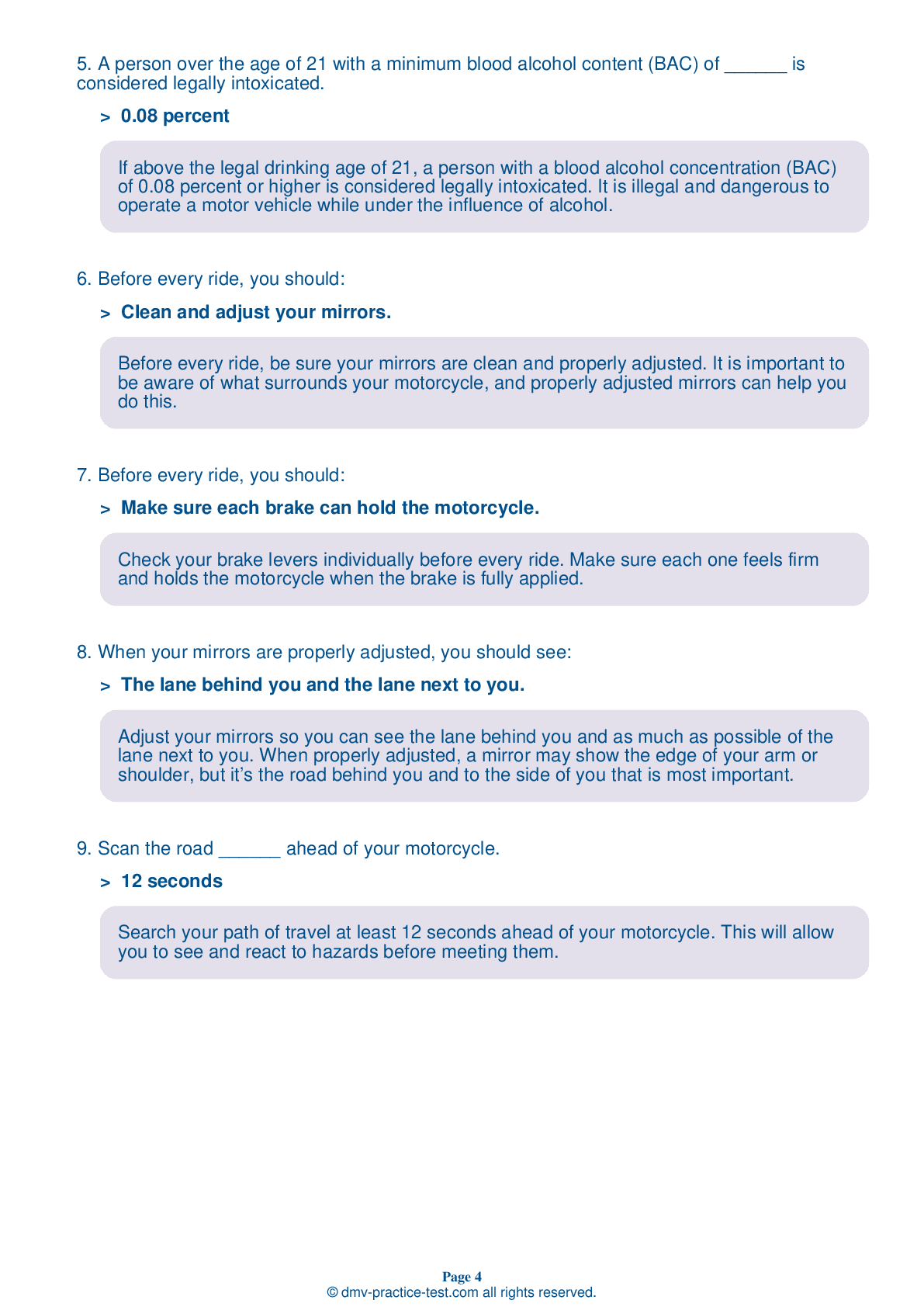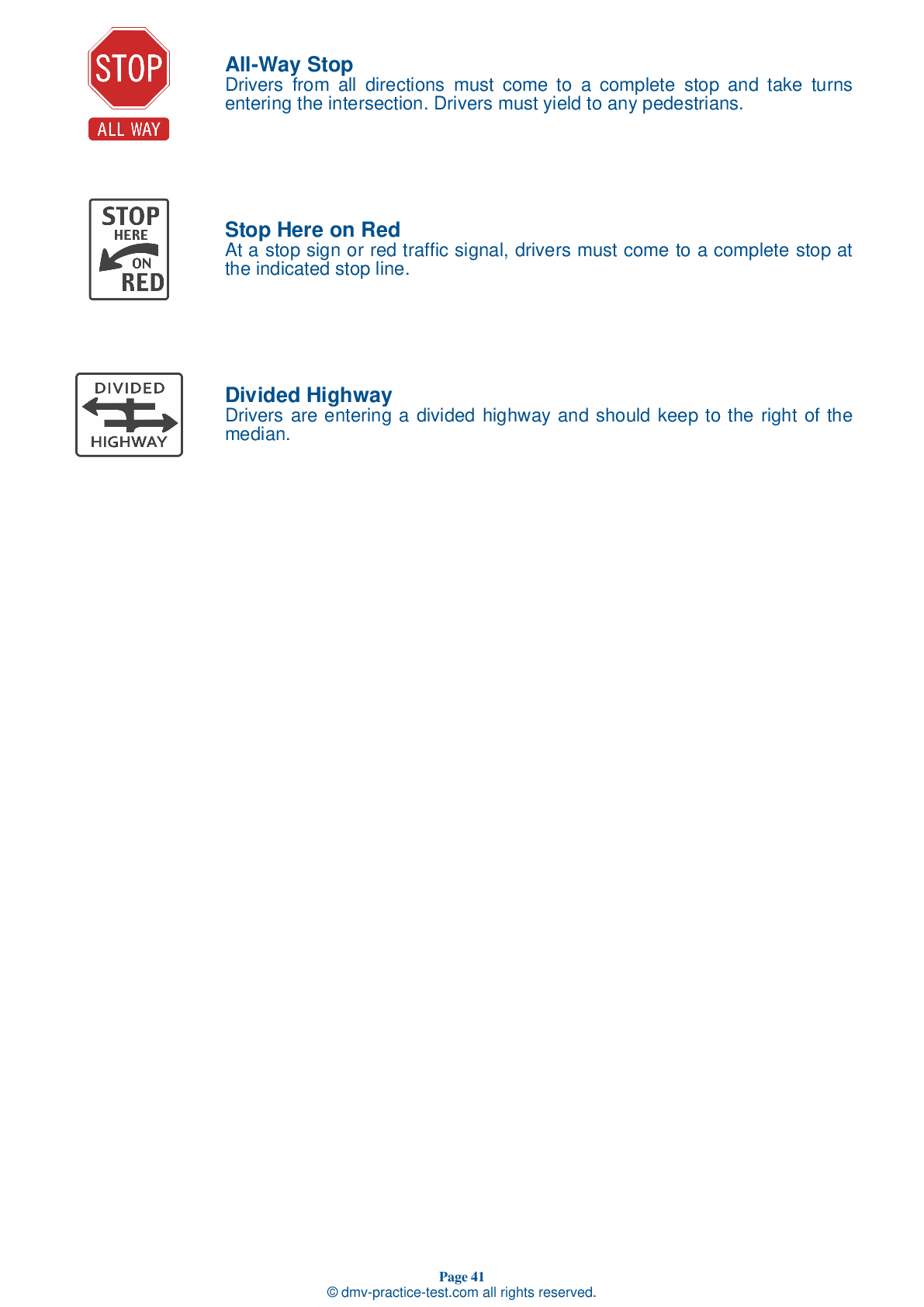DMV Permit Test #1
Motorcycle Test | License CT 2025 | FREE Online Practice! #1 Page 3 of 3
Take this FREE motorcycle test (license in CT 2025) to check your knowledge of the road rules. To improve your results, download a motorcycle handbook online, study theory, and practice for free on our website. Still worried about how to get a motorcycle license in Connecticut in 2025? Check our website for more sample tests, train as much as possible, and boost your grades!
16
12
16
11 . Refusing to take a breath test when requested by an officer:
Will result in legal consequences.
By riding on Connecticut roadways, you automatically consent to taking a chemical test when it is requested by an officer. Refusing a chemical test will result in license suspension.
12 . Most motorcycle crashes occur:
When the rider has been on the road for a full day.
Most motorcyclists involved in crashes are traveling at speeds of 30 mph or less at the time of the crash. Most crashes occur on short trips of less than five miles in length.
13 . To operate a motorcycle on Connecticut roadways, you must have a ______ endorsement.
Class M
A Class M motorcycle endorsement is required to operate a motorcycle on Connecticut roads. A Class M endorsement is not required to operate a motor-driven cycle, but the operator of a motor-driven cycle must have a valid driver license.
14 . When riding with a passenger, you should:
Try to squeeze into smaller gaps in traffic.
The added weight of a passenger will affect the handling of your motorcycle. Expect your motorcycle to accelerate more slowly than usual, turn more slowly than usual, and require extra space to come to a complete stop. Ride more slowly, start slowing sooner when approaching a stop, open up a larger space cushion, and wait for larger gaps when crossing, entering, or merging into traffic.
15 . Before riding, a motorcycle operator should check the clutch. A properly working clutch should feel:
Tight and rough.
Check your clutch and throttle before riding your motorcycle. The throttle should snap back when you let go and the clutch should feel tight and smooth.
16 . Motorcycle riders should:
Only use a turn signal when turning left.
Road users should always signal their intentions before changing lanes, turning, or merging into traffic. Communicating with other drivers is an important part of preventing collisions.
Need Motorcycle Insurance? No problem!
Compare the best rates in Connecticut and find a personalized policy that meets your needs.
1. Are You Currently insured ?
2. Married ?
3. Do you own your Home?
4. Have you or a Family Member Honorably Served in U.S. Military ?
5. Your Name
6. Age
7. Zip code
Ranked by best match
2025 Connecticut | Frequently Asked Questions
In Connecticut, to acquire a motorcycle driver's license, you must first obtain a motorcycle learner's permit by passing a knowledge test. After practicing with the permit, you can take the on-cycle skills test. Upon passing, you'll receive a motorcycle endorsement on your driver's license. Remember, you must also be at least 16 years old and have parental consent if under 18.
In Connecticut, the minimum age for obtaining a motorcycle driver's license is 16 years old. However, if you're under 18, you must obtain parental consent and complete both the Connecticut-approved novice motorcycle safety course and a standard driver's education course before applying for the license.
Yes, you do need a dedicated license for motorcycle riding in Connecticut. You can either obtain a motorcycle endorsement on your existing driver's license or a separate motorcycle-only license if you do not have a regular driver's license. Both require passing a knowledge test and an on-cycle skills test, or completing an approved safety course.
For a motorcycle license in Connecticut, you need a valid Connecticut driver's license, proof of identity, Social Security number, and Connecticut residency. If you've completed a Motorcycle Safety Foundation course, bring your completion certificate. If you're under 18, you also need a parental consent form. Fees for written and on-cycle tests apply, unless waived through course completion.
Yes, if you're applying for a motorcycle license in Connecticut without taking an approved training course, you need to take a written exam. It covers topics like motorcycle operation, traffic laws related to motorcycles, safe riding techniques, and handling emergency situations. The test is designed to evaluate your knowledge and understanding of operating a motorcycle safely.
The Connecticut motorcycle written test covers a variety of topics related to motorcycle safety and operation. These include rules of the road, motorcycle laws, handling dangerous surfaces, carrying passengers and cargo, group riding, avoiding collisions, and handling emergencies. The test is designed to assess your knowledge and understanding of safe motorcycle riding practices.
Yes, in Connecticut, if you complete a Motorcycle Safety Foundation (MSF) Basic Rider Course, you can waive the written and on-cycle driving tests required for a motorcycle endorsement. You must provide the DMV with the course completion certificate. However, you still need to pass the vision test and pay the appropriate fees.
To enroll in a motorcycle training course in Connecticut, you first need to choose a DMV-approved provider. Then, visit their website or call them directly to register for the course. You'll need to provide your personal information and pay any associated fees. The courses usually include classroom instruction and hands-on training. Some providers may require you to have a motorcycle learner's permit before enrolling.
No, you don't necessarily need to own a motorcycle for the license test in Connecticut. You can use any legally registered and insured motorcycle that passes a safety inspection. However, if you're a learner's permit holder, remember that you cannot ride on limited-access highways to get to the test site.
Yes, you can use a friend's motorcycle for the Connecticut driver's license evaluation. However, the motorcycle must be legally registered, insured, and pass a safety inspection. Moreover, you must have a way to legally transport the motorcycle to the test location, as learner's permit holders cannot ride on limited-access highways.
Yes, during the Connecticut motorcycle driving exam, you'll be tested on specific handling skills. These skills include starting and stopping, turning and swerving, quick stops, and obstacle avoidance. The exam also tests your ability to balance at low speeds, accelerate smoothly, and shift gears properly. It's crucial to demonstrate control and safety throughout the test.
Yes, new motorcycle drivers in Connecticut must first obtain a motorcycle learner's permit, which has several restrictions. These include no passengers, no riding on limited-access highways, and no riding after dark. After practicing with a permit, riders can then take a skills test to receive a motorcycle endorsement on their driver's license.
Yes, your Connecticut motorcycle license or endorsement is valid throughout the United States. It allows you to operate a motorcycle in all states under the Full Faith and Credit Clause of the U.S. Constitution. However, you must follow the specific motorcycle laws of the state you are in, as they can vary from Connecticut's laws.
In Connecticut, only motorcycle operators and passengers under 18 are required by law to wear a helmet. However, it's strongly recommended that all riders wear helmets for their safety, regardless of age. Helmets can greatly reduce the risk of serious injury or death in the event of an accident.
Yes, Connecticut offers two types of motorcycle licenses: a full motorcycle endorsement (M endorsement) and a motorcycle learner's permit. The M endorsement allows you to drive motorcycles without restrictions, while the learner's permit allows you to practice driving under certain restrictions. The type of license you need depends on your age and driving experience.
Yes, you can add supplementary endorsements to your motorcycle license in Connecticut. These might include endorsements for different classes of motorcycles or specific types of vehicles like three-wheeled motorcycles. However, each endorsement may require additional testing or training. It's best to check with the Connecticut Department of Motor Vehicles for specific requirements.
Yes, it is possible to take the motorcycle license test in different languages in Connecticut. The Connecticut Department of Motor Vehicles offers the test in several languages including Spanish, Polish, Portuguese, Italian, French, and others. It's recommended to check with your local DMV office for specific language availability.
An effective strategy to prepare for the motorcycle license test in Connecticut includes studying the Connecticut Motorcycle Operator's Manual thoroughly, taking practice tests to familiarize yourself with the format and types of questions, and understanding all road signs and rules. Practical training, if possible, can also help you better understand the riding techniques and safety measures.
Yes, the motorcycle written exam in Connecticut can be taken in languages other than English. The Connecticut Department of Motor Vehicles offers the written test in several languages, including Spanish, Polish, Portuguese, Italian, French, and more. However, it's advisable to check with your local DMV for the availability of specific languages.
If you do not pass the motorcycle written test in Connecticut, you are allowed to retake it. However, there is a mandatory 7-day waiting period before you can retake the test. It is advisable to use this time to study and better prepare for your next attempt. There may also be additional fees for retesting.



